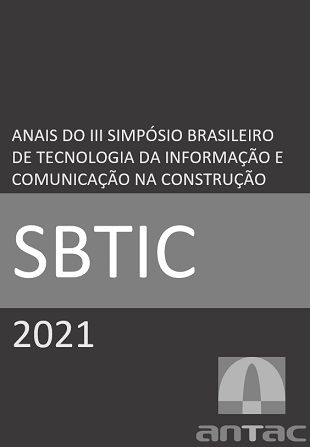Estudo de interoperabilidade entre software BIM e softwares de análise energética de edificações (BES)
DOI:
https://doi.org/10.46421/sbtic.v3i00.588Palavras-chave:
Análise energética, BES, BIM, InteroperabilidadeResumo
A utilização de softwares BIM (Building Information Model) e BES (Building Energy Simulation) facilitam as análises energéticas das edificações e tornam este processo preciso e otimizado. No entanto, para que sejam obtidos resultados consistentes, faz-se necessário garantir a interoperabilidade entre esses. Nesta pesquisa, foi realizado um estudo de caso para verificar o nível de interoperabilidade de três softwares BES (eQUEST®, IES-VE® e GBS®), através da exportação de um projeto modelo desenvolvido em software BIM (Revit®). Para a avaliação do desempenho em relação a interoperabilidade entre os softwares, foram analisados cinco critérios e, com base nas análises destes e nos resultados encontrados, conclui-se que o eQUEST® apresentou as melhores condições de interoperabilidade dentre as opções analisadas.
Downloads
Referências
AMERICAN NATIONAL STANDARDS INSTITUTE. NORRAE STANDARD 90-1: Energy Standard for Buildings Except Low-Rise Residential Buildings. Atlanta, 2013.
ANDRADE, M. L. V. X.; RUSCHEL. R. C. Interoperabilidade de aplicativos BIM usados em arquitetura por meio do formato IFC. Gestão & Tecnologia de Projetos. v.4, p76-111. 2009.
AUTODESK. Green Building Studio. Disponível em: < https://gbs.autodesk.com/GBS/>. Acesso em: 01/2020.
CHEN, S. et al. Investigation of interoperability between building information modelling (BIM) and building energy simulation (BES). International Review of Applied Sciences and Engineering, v. 9, p.137-144. 2018
HAAGENRUD, S. et al. STANDINN Deliverable D15 IFC and IFD feasibility for innovative sustainable housing. EUROPA INNOVA, p.86. 2007.
INMET – Instituto Nacional de Metereologia. Tabelas de dados das estações. Disponível em: < http://www.inmet.gov.br>. Acesso em 13 de agosto de 2018.
INSTITUTO NACIONAL DE METROLOGIA, NORMALIZAÇÃO E QUALIDADE INDUSTRIAL (INMETRO). Regulamento Técnico da Qualidade do Nível de Eficiência Energética de Edifícios Comerciais, de Serviços e Públicos. Anexo da Portaria INMETRO nº 163/2009. 2009.
KIVINIEMI, A. Support for Building Elements in the IFC 2x3 Implementations based. 6th Certification Workshop Result. 2007.
KOTA, S. et al. Building Information Modeling (BIM)-based daylighting simulation and analysis. Energy and Buildings 81, p. 391-403. Elsevier B.V. 2014.
MOON, H.J. et al. Case studies for the evaluation of interoperability between a BIM based architectural model and building performance analysis programs. 12th Conference of International Building Performance Simulation Association, p.1521-1526. 2011.
OSELLO, A. et al. Architecture data and energy efficiency simulations: BIM and interoperability standards. 12th Conference of International Building Performance Simulation Association, p.2210-2217. 2011.
PORSANI, G.B. et al. Interoperability between Building Information Modelling (BIM) and Building Energy Model (BEM). Applied Sciences, v.11, p.2167.2021.
QUEIRÓZ. G.R. Análise da interoperabilidade entre os programas computacionais Autodesk Revit e EnergyPlus para simulação térmica de edificações. Tese (Mestrado em Engenharia Civil) – Programa de Pós-Graduação em Engenharia Civil, Universidade Federal de Santa Maria. Santa Maria, p.181. 2016.
WONG, J.; ZHOU, J. Enhancing environmental sustainability over building life cycles through green BIM: A review. Automation in Construction 57, p.156 – 165. Elsevier B.V. 2015.
AMERICAN NATIONAL STANDARDS INSTITUTE. NORRAE STANDARD 90-1: Energy Standard for Buildings Except Low-Rise Residential Buildings. Atlanta, 2013.
ANDRADE, M. L. V. X.; RUSCHEL. R. C. Interoperabilidade de aplicativos BIM usados em arquitetura por meio do formato IFC. Gestão & Tecnologia de Projetos. v.4, p76-111. 2009.
AUTODESK. Green Building Studio. Disponível em: < https://gbs.autodesk.com/GBS/>. Acesso em: 01/2020.
CHEN, S. et al. Investigation of interoperability between building information modelling (BIM) and building energy simulation (BES). International Review of Applied Sciences and Engineering, v. 9, p.137-144. 2018
HAAGENRUD, S. et al. STANDINN Deliverable D15 IFC and IFD feasibility for innovative sustainable housing. EUROPA INNOVA, p.86. 2007.
INMET – Instituto Nacional de Metereologia. Tabelas de dados das estações. Disponível em: < http://www.inmet.gov.br>. Acesso em 13 de agosto de 2018.
INSTITUTO NACIONAL DE METROLOGIA, NORMALIZAÇÃO E QUALIDADE INDUSTRIAL (INMETRO). Regulamento Técnico da Qualidade do Nível de Eficiência Energética de Edifícios Comerciais, de Serviços e Públicos. Anexo da Portaria INMETRO nº 163/2009. 2009.
KIVINIEMI, A. Support for Building Elements in the IFC 2x3 Implementations based. 6th Certification Workshop Result. 2007.
KOTA, S. et al. Building Information Modeling (BIM)-based daylighting simulation and analysis. Energy and Buildings 81, p. 391-403. Elsevier B.V. 2014.
MOON, H.J. et al. Case studies for the evaluation of interoperability between a BIM based architectural model and building performance analysis programs. In: CONFERENCE OF INTERNATIONAL BUILDING PERFORMANCE SIMULATION ASSOCIATION, 12, Sidney, Australia. Proceedings [...]. Sydney, Australia: 2011. p.1521-1526. .
OSELLO, A. et al. Architecture data and energy efficiency simulations: BIM and interoperability standards. In: CONFERENCE OF INTERNATIONAL BUILDING PERFORMANCE SIMULATION ASSOCIATION, 12, Sidney, Australia. Proceedings [...]. Sydney, Australia: 2011. p.2210-2217. .
QUEIRÓZ. G.R. Análise da interoperabilidade entre os programas computacionais Autodesk Revit e EnergyPlus para simulação térmica de edificações. Tese (Mestrado em Engenharia Civil) – Programa de Pós-Graduação em Engenharia Civil, Universidade Federal de Santa Maria. Santa Maria, p.181. 2016.
WONG, J.; ZHOU, J. Enhancing environmental sustainability over building life cycles through green BIM: A review. Automation in Construction 57, p.156 – 165. Elsevier B.V. 2015.
Publicado
Como Citar
Edição
Seção
Licença
Copyright (c) 2021 SIMPÓSIO BRASILEIRO DE TECNOLOGIA DA INFORMAÇÃO E COMUNICAÇÃO NA CONSTRUÇÃO

Este trabalho está licenciado sob uma licença Creative Commons Attribution 4.0 International License.
Adota-se Atribuição 4.0 Internacional (CC BY 4.0). Ver detalhamento em https://creativecommons.org/licenses/by/4.0/deed.pt_BR

